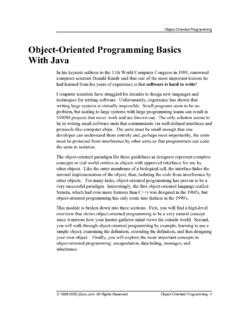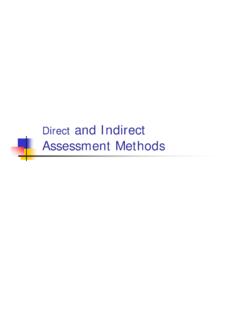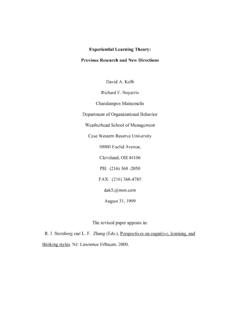Transcription of Introduction to Java - Computer Science
1 Intro to java 1996-2003 All Rights to java -1 Introduction to JavaTopics in this section include: Source code and compilation Class files and interpretation Applications versus applets java language fundamentals User-defined data types with java java syntaxOverviewJava is a modern, evolutionary computing language that combines an elegantlanguage design with powerful features that were previously available primarily inspecialty languages. In addition to the core language components, java softwaredistributions include many powerful, supporting software libraries for tasks suchas database, network, and graphical user interface (GUI) programming. In thissection, we focus on the core java language is a true object-oriented (OO) programming language. The main implication ofthis statement is that in order to write programs with java , you must work withinits object-oriented languages provide a framework for designing programs thatrepresent real-world entities such as cars, employees, insurance policies, and soon.
2 Representing real-world entities with nonobject-oriented languages is difficultbecause it's necessary to describe entities such as a truck with rather primitivelanguage constructs such as Pascal's record, C's struct, and others that representdata behavior of an entity must be handled separately with language constructssuch as procedures and/or functions, hence, the term procedural programminglanguages. Given this separation, the programmer must manually associate a datastructure with the appropriate procedures that operate on, that is, manipulate, contrast, object-oriented languages provide a more powerful class constructIntro to JavaIntro to java -2 1996-2003 All Rights representing user-defined entities. The class construct supports the creationof user-defined data types, such as Employee, that represent both the data thatdescribes a particular employee and the manipulation or use of that programs employ user-defined data types liberally.
3 Designing nontrivial Javaclasses requires, of course, a good working knowledge of java syntax. Thefollowing sections, illustrate java syntax and program design in the context ofseveral java class Data TypesWith java , every Computer program must define one or more user-defined datatypes via the class construct. For example, to create a program that behaves likea dog, we can define a class that (minimally) represents a dog:class Dog { void bark() { ("Woof."); }}This user-defined data type begins with the keyword class, followed by thename for the data type, in this case, Dog, followed by the specification of what itis to be a dog between opening and closing curly brackets. This simple exampleprovides no data fields, only the single behavior of barking, as represented by themethod bark().
4 MethodsA method is the object-oriented equivalent of a procedure in nonobject-orientedlanguages. That is, a method is a program construct that provides the mechanism(method) for performing some act, in this case, barking. Given an instance of someentity, we invoke behavior with a dot syntax that associates an instance with amethod in the class definition:Method Invocation Syntax<instance>.<behavior>()<variable> = <instance>.<behavior>(<arguments>..)To elicit a bark from a dog fido, for example, the operation would ()Intro to java 1996-2003 All Rights to java -3 Syntactically, java supports passing data to a method and capturing a valuereturned from a method, neither of which takes place in the previous is a strongly typed language, meaning that it expects variables, variablevalues, return types, and so on to match properly, partly because data types areused to distinguish among multiple methods with the same name.
5 Method returntypes and parameters are specified during definition:Method Definition Syntaxvoid <method-name>(<arguments>..) { <statements>..}<return-type> <method-name>(<arguments>..) { <statements>..}Historically, the combination of method name, return type, and argument list iscalled the method signature. With modern OO languages, a class may definemultiple methods with the same name, as long as they are distinguishable by theirsignatures; this practice is called method overloading. java has the restriction thatreturn type does not contribute to the method signature, thus, having twomethods with the same names and arguments, but different return types is the current example, the return type of void indicates that bark() does notcompute any value for delivery back it to the invoking program component.
6 Also,bark() is invoked without any arguments. In object parlance, invoking a methodrelative to a particular object (a class instance) is often called message passing. Inthis case, the message contains no supplemental data (no arguments).For now, if we create an instance of Dog, it can bark when provoked, but we haveno way of representing data, for example, how many times it will bark, its breed,and so on. Before looking at language constructs that will make the Dog data typemore versatile, we must consider a mechanical aspect of the java language, namely,what's necessary to run a ApplicationsWith the java class and method syntax in hand, we can design a java applications consist of one or more classes that define data and applications are translated into a distilled format by a java compiler.
7 ThisIntro to JavaIntro to java -4 1996-2003 All Rights format is nothing more than a linear sequence of operation-operand(s)tuples:<operation> <operand> <operation> <operand> <operation> <operand>This stream of data is often called a bytecode stream, or simply java operations in the bytecode stream implement an instruction set for a so-calledvirtual machine (software-based instruction processor), commonly called a Javavirtual machine (JVM). Programs that implement the JVM simply process Javaclass files, sometimes specific to a particular environment. For example, java -enabled web browsers such as Netscape Navigator and Internet Explorer include aJVM implementation. Standalone programs that implement the JVM are typicallycalled java java compiler stores this bytecode stream in a so-called class file with thefilename extension.
8 Class. Any java interpreter can read/process this stream--it"interprets" each operation and its accompanying data (operands). Thisinterpretation phase consists of (1) further translating the distilled java bytecodesinto the machine instructions for the host Computer and (2) managing theprogram's execution. The following diagram illustrates the compilation andexecution processes: java class files are portable across platforms. java compilers and interpreters aretypically not portable; they are written in a language such as C and compiled toIntro to java 1996-2003 All Rights to java -5the native machine language for each Computer platform. Because java compilersproduce bytecode files that follow a prescribed format and are machineindependent, and because any java interpreter can read and further translate thebytecodes to machine instructions, a java program will run class definition such as Dog is typically stored in a java source file with amatching name, in this case, A java compiler processes the source fileproducing the bytecode class file, in this case, In the case of Dog,however, this file is not a java java program consists of one or more class files, one of which must define aprogram starting does not.
9 In other words, this starting point isthe difference between a class such as Dog and a class definition that implements aprogram. In java , a program's starting point is defined by a method namedmain(). Likewise, a program must have a well-defined stopping point. In java ,one way to stop a program is by invoking/executing the (system) method exit().So, before we can do anything exciting, we must have a program that starts andstops cleanly. We can accomplish this with an arbitrary, user-defined data typethat provides the main() and exit() behavior, plus a simple output operation toverify that it actually works:public class SimpleProgram { public static void main(String[] args) { ("This is a simple program."); (0); }}The signature for main() is invariable; for now, simply define a program entrypoint following this example--with the modifiers public and static and thereturn type void.
10 Also, System ( ) is a standard class suppliedwith every java environment; it defines many utility-type operations. Twoexamples are illustrated here: (1) displaying data to the standard output device(usually either an IDE window or an operating system command window) and (2)initiating a program that the 0 in the call to exit() indicates to the calling program, the Javainterpreter, that zero/nothing went wrong; that is, the program is terminatingnormally, not in an error this point, we have two class definitions: one, a real-world, user-defined datatype Dog, and the other, a rather magical class that connects application-specificIntro to JavaIntro to java -6 1996-2003 All Rights with the mechanics of starting and stopping a is a good time to get acquainted with your java development environment.





